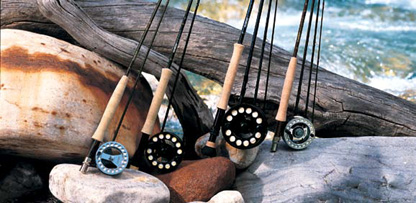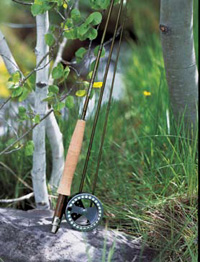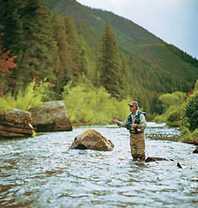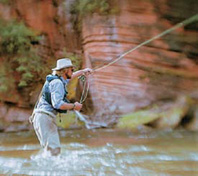Rods
Because fly fishing manufacturers offer hundreds of different rods for sale, choosing the right rod for you can be perplexing, even frustrating. All fly rods, however, differ primarily in their actions, in the materials of their construction, and in their lengths.
Rod makers classify the basic actions of their rods as slow, medium, and fast. A slow action rod flexes throughout its tip, mid, and butt sections. A medium action rod flexes primarily in its mid and tip sections. A fast action rod flexes primarily in its tip section.
On their rods, all reputable rod makers list the weight of line the rod will cast. The first thirty feet of a fly line weighs a uniform weight, and the rod’s action is balanced to cast this known and specified weight. All manufacturers of fly lines designate uniform numbers for the weights of their lines. Regardless of maker, fly lines come in weights from one to fifteen. Consequently, all fly rods, fly lines, and fly reels are matched to these weight designations: the smaller the number, the lighter the line weight. Below, I’ve listed common line and rod weights according to their uses:

1-2 Weight Lines and Rods
Designed for casting to small fish at short distances. In addition, these rods are designed to make delicate deliveries for tiny flies. Best for small trout and panfish like bluegills and crappies.
3 Weight Lines and Rods
Designed for casting short to medium distances with small flies; used for trout and panfish.
4 Weight Lines and Rods
Designed for casting medium sized flies delicately at medium distances; used for trout and panfish.
5 Weight Lines and Rods
Designed for accurately casting short, medium, and long distances with a wide size range of flies. Effective for trout, panfish, smallmouth bass, largemouth bass.
6 Weight Lines and Rods
A general all-around rod with many uses; designed for casting all distances well. Can be used for trout, pan-fish, bass, and steelhead.
7-8 Weight Lines and Rods
Designed for casting long distances for very large trout, bass, and big fish up to about fifteen pounds, including Atlantic and Pacific salmon and steelhead.


9-10 Weight Lines and Rods
Designed for casting long distances with large flies for heavy fish of thirty to forty pounds: bonefish, permit, striped bass, bonito, albacore, bluefish, redfish, and snook.
11-15 Weight Lines and Rods
Heavy salt water rods for large fish: billfish, tarpon, etc..

Rod makers manufacture rods using a variety of materials: fiberglass, bamboo, graphite, and graphite composites (which may include boron or titanium). Graphite rods are the most popular because of their light weights and relatively inexpensive costs and the wide assortment of weights and sizes.
Fiberglass rods are rarely used because of their limited choices of actions and heavier weights. Bamboo rods are costly because of their complex manufacturing process. In addition, bamboo rods weigh more than graphite and fiberglass rods and their actions tend to be slower than the graphite’s. The boron and titanium graphite composites are unusually strong fly rods with quick recovery rates. These rods cast well both short and long distances.
Rod lengths can vary from six to fifteen feet in length. A short rod (under eight feet) is well suited to fish the small, brushy streams with overhanging vegetation. A medium length fly rod (eight to nine feet), however, is the most versatile and can be used to fish both small and large streams. The longer rods (9 1/2-15 feet) are specialized rods used to make high backcasts required under some conditions. These long rods nevertheless make handling line much easier than shorter rods do.
Windy areas call for high line speeds to cut through the wind. Fast action rods more easily create fast line speeds than medium and slow action rods, although good casters can create high line speeds with even the slowest action rods.
A beginning caster will almost always cast farther with a fast action rod whereas an accomplished caster can make long casts with slow, medium, or fast action rods. On the other hand, slower action rods create delicate fly presentations more easily than fast action rods.
Regardless, big fish and big flies are easier to control with faster action rods. Truly large fish can require longer and faster action rods to lift and move them.

In addition, fast action rods generate tighter loops than slower actions, and in casting, loop size is important. The tighter or narrower the loop, the more efficiently the line sails through the air. Wide loops create more air resistance simply because of their larger surface area. Tight loops cast farther with faster line speeds than wider loops, although delicacy of presentation suffers from high line speeds.
Slower action rods cushion the stress on light tippets. Faster action rods need heavier, stronger tippets.
Because fast action rods demand precise timing in the casting stroke, a medium action rod is the best choice for a beginner. For one thing, a medium action rod is more forgiving than a fast action rod, and with a medium action rod, a beginning caster can still make a good cast even if his or her timing is a little off.
When purchasing a rod, take into account where you will be using it. How windy is the environment on an average day? How well do you cast? How large are the fish you intend to catch and the flies you intend to use?
The fly fishing manufacturers have perfected their trade, and nearly every rod sold today is of good quality. All of the name brand manufacturers sell quality rods in both their entry-level rods and in their high end products. Simply put, choose a rod in your price range and buy from a name brand manufacturer. Select a rod action and a rod length appropriate to your fishing conditions.


© 2025 The Gale Group, Inc. All rights reserved.
© 2025 Perigee Learning LLC. All rights reserved.
LoveTheOutdoors.com is owned and operated by Advameg, Inc. © 2025 Advameg, Inc.
Camping Adventures • Dutch Oven Cooking • Sports Knots
Fly Tying • Freshwater Fishing • Fly Fishing

